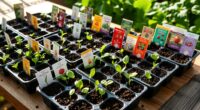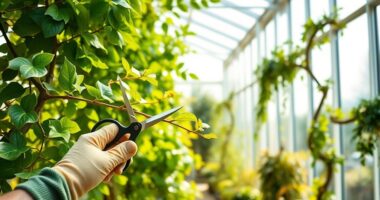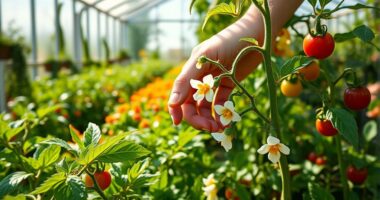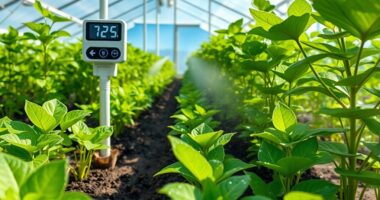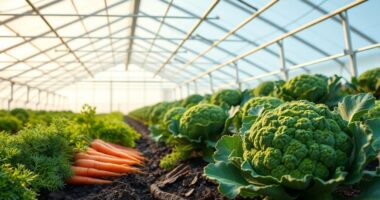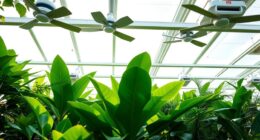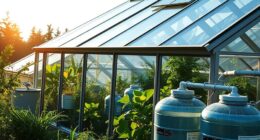To grow lettuce year-round in your greenhouse, maintain optimal temperatures between 50-70°F during the day and avoid letting it drop below 35°F at night. Choose heat-tolerant and disease-resistant varieties, like Batavia and Dorian. Use shallow planting techniques, ensuring seeds receive light to germinate. Manage pests through companion planting and keep air circulation strong to prevent disease. By following these guidelines, you can create a thriving lettuce crop and discover even more effective strategies.
Key Takeaways
- Maintain greenhouse temperatures between 50-70°F during the day and above 35°F at night for optimal lettuce growth year-round.
- Select heat-tolerant and disease-resistant lettuce varieties like Batavia and Dorian to ensure continuous harvests throughout the seasons.
- Use shade cloth in warmer months and employ evaporative cooling systems to regulate temperature and humidity effectively.
- Implement regular ventilation and air circulation to prevent diseases and promote healthy growth in the greenhouse environment.
- Practice the cut-and-come-again harvesting method to encourage regrowth and extend the harvest period for lettuce.
Understanding the Greenhouse Environment for Lettuce

When you set up a greenhouse for growing lettuce, understanding the environment is crucial to your success. High ceilings and gutter heights of at least 8 feet help manage temperature fluctuations effectively.
In warmer climates, consider using 50% shade cloth from April to October to regulate heat. It’s essential to maintain optimal temperatures; lettuce thrives between 50-70°F during the day and should never drop below 35°F at night.
Employ evaporative cooling systems to keep temperatures lower than outside, and ensure regular ventilation for air exchange. Adjust temperature control seasonally to accommodate external conditions, maintaining consistent moisture levels to support healthy growth.
Selecting the Right Lettuce Varieties
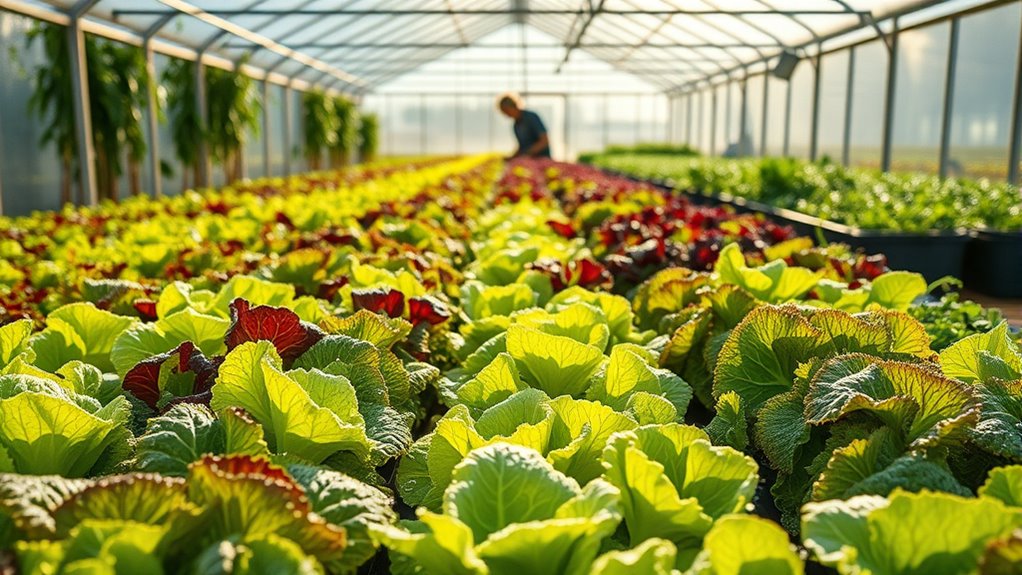
Creating the right greenhouse environment sets the stage for selecting lettuce varieties that thrive year-round. Start by choosing heat-tolerant options like Batavia or Chicarita, which resist bolting and perform well in warmer temperatures.
For disease resistance, varieties like Dorian and Chicarita protect against downy mildew and lettuce mosaic virus, ensuring healthier crops.
Don’t overlook growth rates; early maturing types like Dorian allow for quick succession planting.
Consider texture and flavor too—Romaine’s crispness and Butterhead’s tenderness can enhance your salads.
Finally, explore vibrant color varieties to make your dishes visually appealing.
Effective Planting Techniques for Lettuce

Successful lettuce planting hinges on understanding the right conditions and techniques. Start by ensuring your greenhouse temperature stays between 45°F and 65°F.
Sow seeds shallowly, about ⅛” to ¼” deep, since they need light to germinate. For spacing, plant seeds 1 inch apart in rows spaced 12-18 inches apart, depending on the variety.
Consistent moisture is vital, so aim for about an inch of water each week, and water gently after sowing to avoid displacing seeds. Regularly feed your lettuce with water-soluble plant food to promote healthy growth.
Don’t forget to prepare your soil by loosening the top inch with a hand fork before planting. Following these tips will help you achieve a thriving lettuce crop year-round.
Utilizing Hydroponic Systems for Optimal Growth
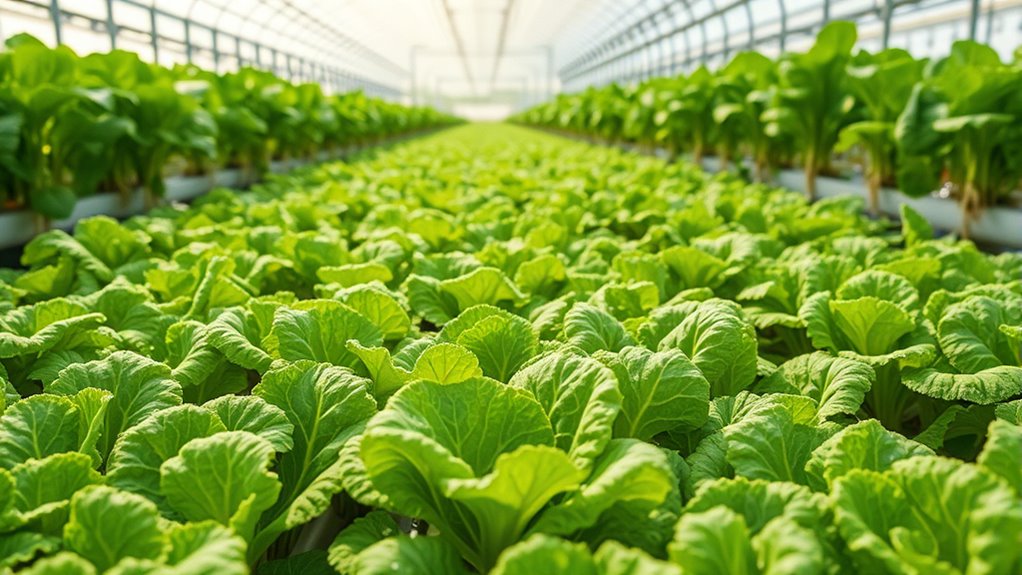
After mastering effective planting techniques, you can take lettuce cultivation to the next level by utilizing hydroponic systems.
These systems, like Nutrient Film Technique (NFT) and Deep Water Culture (DWC), provide optimal growth conditions without soil. Use growing mediums such as rockwool or coconut coir to support your lettuce roots.
Regularly monitor and adjust pH and EC levels to ensure your plants thrive. Hydroponics offers higher yields, uses up to 90% less water, and allows for year-round production in controlled environments.
You’ll also enjoy consistent crop quality and reduced chemical use. Just remember to invest in essential equipment like nutrient tanks and pumps, and maintain your system for the best results.
Happy growing!
Managing Pests and Diseases in Your Greenhouse

While growing lettuce in a greenhouse can lead to abundant harvests, it also attracts a variety of pests and diseases that can threaten your crop.
To manage pests like aphids and caterpillars, consider companion planting with garlic and chives, and use insect netting to keep them at bay. Incorporate biological controls, such as lady beetles, to naturally reduce aphid populations.
For disease prevention, maintain good air circulation and avoid overhead irrigation to combat issues like downy mildew. Regularly practice sanitation by removing crop residues and using steam to disinfect soil.
With these strategies, you’ll create a healthier environment for your lettuce, ensuring a fruitful and sustainable growing experience in your greenhouse.
Harvesting Lettuce for Continuous Production

To ensure a continuous supply of fresh lettuce, it’s essential to adopt effective harvesting techniques that promote regrowth.
Use the cut-and-come-again method by harvesting outer leaves while leaving the inner leaves intact; this allows your plants to regrow for multiple harvests.
Timing is crucial—harvest in the early morning when temperatures are cooler to minimize wilting.
Always use sharp, sanitized scissors or garden shears for clean cuts, preventing disease transmission.
Take no more than a third of the plant’s leaves at once to maintain healthy growth.
Additionally, practice selective leaf picking, choosing mature outer leaves.
This approach not only maximizes yield but also supports sustainability by reducing waste in your greenhouse.
Maintaining Soil Health and Fertility
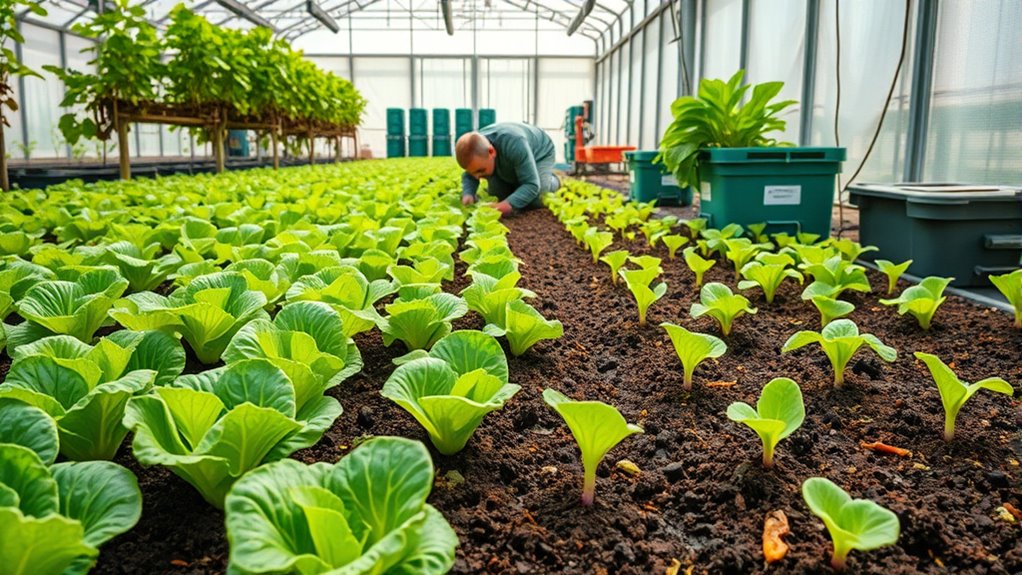
Maintaining soil health and fertility is vital for growing lettuce successfully year-round. Start with a well-draining soil mix of peat moss, vermiculite, and compost to enrich your soil and promote healthy growth.
Ensure balanced pH levels between 6.0 and 6.5, and maintain a good nutrient balance of nitrogen, phosphorus, and potassium. Fertilize every two weeks using balanced fertilizers, whether liquid or slow-release.
Regularly test your soil to adjust nutrient applications as needed. Incorporate crop rotation to prevent depletion and reduce disease risk.
Monitor moisture levels to prevent overwatering, which can lead to root rot. Finally, keep the soil aerated to support robust root health, ensuring your lettuce thrives throughout the year.
Seasonal Considerations for Year-Round Growth
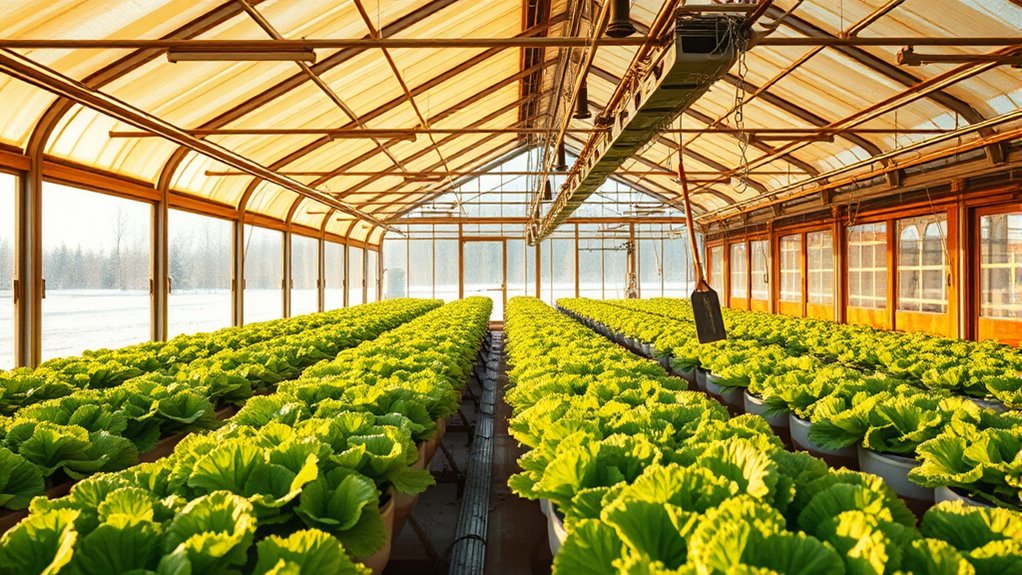
As you plan for year-round lettuce growth, understanding seasonal considerations is crucial. In early spring, opt for fast-growing varieties like Bronze Arrow.
As temperatures rise in late spring, select heat-tolerant types such as Merlot. During the summer, focus on heat-resistant varieties to prevent bolting. In fall, choose disease-resistant and cold-tolerant options. For winter, go with cold-hardy varieties like Winter Density.
Keep temperatures between 50-70°F during the day and ensure proper ventilation in summer. In winter, maintain warmth above freezing.
Provide 5-6 hours of sunlight daily, using supplemental lighting in winter. Consistent watering is key, and monitoring humidity prevents fungal issues.
Finally, implement pest management strategies to maintain healthy crops throughout the seasons.
Frequently Asked Questions
What Tools Do I Need for Greenhouse Lettuce Growing?
To successfully grow lettuce in your greenhouse, you’ll need several essential tools.
Start with ventilation systems for air circulation and heating equipment to maintain warm temperatures. An irrigation system ensures consistent watering, while temperature and humidity sensors help you monitor conditions.
Don’t forget soil mixers and pH test kits for soil health.
Finally, have planting tools like seeding trays, transplanting tools, and lettuce field knives ready for planting and harvesting.
How Do I Choose the Right Greenhouse Size for Lettuce?
Choosing the right greenhouse size for your lettuce is like crafting a masterpiece; every inch counts!
You’ll need about 1 square foot per head at harvest, so calculate your desired yield.
Don’t forget to factor in space for seedlings, equipment, and non-growing areas—about 25% of your greenhouse.
With careful planning, you’ll maximize efficiency and minimize labor costs, ensuring your lettuce thrives in its leafy paradise.
Can I Grow Lettuce Without a Greenhouse?
Yes, you can definitely grow lettuce without a greenhouse! You can use indoor spaces with grow lights, or try container gardening on a sunny patio.
Lettuce thrives in cooler temperatures, so keep it in the right range and ensure your soil is well-draining. Regularly check for pests and maintain consistent moisture.
How Do I Manage Energy Costs in a Greenhouse?
Managing energy costs in a greenhouse can feel overwhelming, but it doesn’t have to be. Start by conducting regular energy audits to spot inefficiencies.
Invest in LED lighting for substantial savings, and consider automated systems to optimize usage.
Use retractable curtains and effective ventilation to control temperature, reducing heating needs.
Lastly, seal any air leaks and explore solar options to further cut costs.
You’ll be amazed at how much you can save!
What Are the Signs of Nutrient Deficiencies in Lettuce?
When you’re growing lettuce, watch for signs of nutrient deficiencies.
If you see older leaves yellowing, it might indicate nitrogen deficiency. Stunted growth and yellowing lower leaves suggest phosphorus issues.
Potassium deficiency often shows as edge burn on older leaves. For calcium, look for necrotic spots on young leaves, while magnesium deficiency causes interveinal chlorosis.
Regular monitoring can help you catch these symptoms early and keep your plants healthy.
Conclusion
Growing lettuce year-round in a greenhouse can be both a rewarding challenge and a simple pleasure. While the outside world may be barren and cold, your greenhouse can flourish with vibrant greens. By mastering the environment, selecting the right varieties, and staying on top of pests, you’ll enjoy fresh, crisp lettuce regardless of the season. Embrace the contrast of nature’s cycles, and let your greenhouse be a sanctuary of growth and abundance, even when the frost bites outside.

